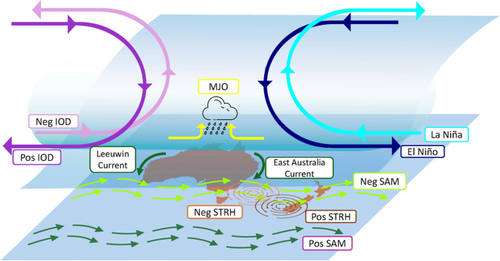Climate Dynamics ( IF 4.6 ) Pub Date : 2024-04-19 , DOI: 10.1007/s00382-024-07226-x Catherine H. Gregory , Neil J. Holbrook , Andrew G. Marshall , Claire M. Spillman

|
As marine heatwaves (MHWs) become more intense and longer lasting due to global warming, understanding the drivers and impacts of these events is crucial for effective marine resource management. This study investigates the influence of El Niño Southern Oscillation (ENSO), the Indian Ocean Dipole (IOD), Southern Annular Mode (SAM), Sub-Tropical Ridge High (STRH), and Madden Julian Oscillation (MJO) on sea surface temperature (SST) anomalies and MHWs around Australia. The aim of this research is to improve our understanding of the drivers of MHWs on sub-seasonal to seasonal (S2S) timescales, which bridges the gap between short-term weather and interannual to long-term climate variability. By analysing SST anomalies and MHWs characteristics during specific driver phases, a simple MHW hazard index is developed. Our findings support previous research indicating that La Niña plays a role in driving MHWs off the coast of Western Australia and reveals a previously unrecognised connection between ocean warming off Queensland and Tasman Sea low-pressure systems associated with the negative phase of the STRH. Our research emphasizes the importance of considering multiple drivers and their compounding effects on MHWs by showing significant changes to typical La Niña MHW patterns with the additional influence of the MJO. By considering drivers acting in the S2S timescale, forecasts can more accurately capture the timing, intensity, and spatial extent of MHW events within a season. These improved forecasts can enhance the ability of marine managers to adapt and allocate resources based on evolving climate conditions, enabling effective implementation of harm minimisation strategies.
中文翻译:

澳大利亚区域海洋热浪的次季节到季节性驱动因素
由于全球变暖,海洋热浪 (MHW) 变得更加强烈和持续时间更长,了解这些事件的驱动因素和影响对于有效的海洋资源管理至关重要。本研究调查了厄尔尼诺南方涛动(ENSO)、印度洋偶极子(IOD)、南方环模(SAM)、副热带高压脊(STRH)和马登朱利安涛动(MJO)对海面温度的影响。澳大利亚各地的 SST)异常和 MHW。这项研究的目的是提高我们对次季节到季节(S2S)时间尺度上的 MHW 驱动因素的理解,从而弥合短期天气与年际到长期气候变化之间的差距。通过分析特定驾驶阶段的 SST 异常和 MHW 特征,开发了一个简单的 MHW 危险指数。我们的研究结果支持了之前的研究,表明拉尼娜现象在推动MHW离开西澳大利亚海岸方面发挥了作用,并揭示了昆士兰州海洋变暖和与STRH负相位相关的塔斯曼海低压系统之间以前未被认识到的联系。我们的研究通过显示典型拉尼娜 MHW 模式在 MJO 的额外影响下的显着变化,强调了考虑多种驱动因素及其对 MHW 的复合影响的重要性。通过考虑 S2S 时间尺度内的驱动因素,预测可以更准确地捕捉一个季节内 MHW 事件的时间、强度和空间范围。这些改进的预测可以增强海洋管理者根据不断变化的气候条件调整和分配资源的能力,从而有效实施危害最小化战略。



























 京公网安备 11010802027423号
京公网安备 11010802027423号